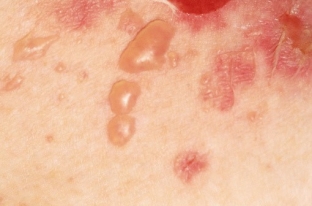Pemphigus vulgaris develops when the immune system fails, when the patient's body begins to produce antibodies to his own cells of the epidermis. The desmosomes binding them are destroyed, and the intercellular space is filled with liquid, forming acantholytic bubbles. Without active therapy started as early as possible, the disease has a poor prognosis. For information on how to choose a treatment regimen for a patient, and in what cases to apply pulse therapy for pemphigus vulgaris, read on estet-portal.com.
Rules for choosing a treatment regimen for pemphigus vulgaris
The overall therapeutic efficacy of treatment for pemphigus vulgaris is always determined by the impact of the initial treatment, so even in mild cases a full-dose regimen should be chosen. Traditionally, a combination of corticosteroids and cytostatics in high doses with prolonged use is prescribed. If the patient's condition is severe or life-threatening, ultra-high doses are prescribed at intervals. In addition, periodic plasmapheresis may be effective, as well as topical treatment to prevent infection and stimulate re-epithelialization of inflamed skin with erosions.
As a traditional therapy for pemphigus vulgaris, including those that manifest only in the oral cavity, a combination of deflazacort at a daily dose of 120-150 mg with azathioprine at a dose of 100 mg is prescribed. Reception in this mode lasts approximately four weeks until the complete disappearance of all active foci.
If the patient's condition is satisfactory, then gradually reduce the dose of steroids:
- deflazacort – the dose is reduced every other day: for example, on even numbers – the initial dose is unchanged, and for odd – 6 mg less;
- azathioprine – the dose does not change, remains the original (for example, 100 mg).
Approximately 6-7 weeks later, depending on the initial dose of deflazacort, the patient's condition is assessed by determining intercellular antibody titers.
If the antibody titers have decreased, and the lesions on the mucous membranes no longer appear, then the dose of deflazacort, which was prescribed every other day, continues to be reduced – but already on a weekly basis until it reaches 45 mg. The dose of azathioprine remains unchanged. The duration of this regimen depends on the course of the disease.
Then the patient continues to take deflazacort at a dose of 45 mg for another two months every other day, then another two months – every third day, then once a week – from six months to two years. In this case, the daily dose of azathioprine 100 mg is maintained.
If the patient cannot take azathioprine, it is replaced with drugs such as cyclophosphamide, chlorambucil, methotrexate, mucophenolate mofetil, which have shown high effectiveness in combination with basic steroids.
If the remission is stable, the disease does not recur within two years, then deflazacort is canceled, and azathioprine can be stopped after another year. In case of recurrence of pemphigus vulgaris, high doses of the above drugs are again prescribed.

Read also: Pemphigus vegetans: why it is important to diagnose it in time
How is pulse therapy performed for pemphigus vulgaris
Pulse therapy is also called shock therapy, since the essence of this procedure is the intravenous administration of a very high doses of drugs in several sessions for a short time. When it comes to pemphigus vulgaris, the patient receives a daily combination of corticosteroids and immunosuppressive drugs in megadoses during pulse therapy. Dexamethasone or methylprednisolone is usually combined with cyclophosphamide.
Standard pulse therapy regimen: slow intravenous infusion of 500 mg methylprednisolone/100 mg dexamethasone diluted in 500 mg 5% dextrose over 1-2 hours on three consecutive days. On the first day, cyclophosphamide at a dose of 500 mg is added to the infusion of corticosteroids. Such three-day pulse procedures are repeated every 28 days, and in especially severe cases – every 14 days. Between pulse treatments, the patient is given oral cyclophosphamide 50 mg/day.
Usually, 6 pulse procedures are sufficient to achieve complete clinical remission, but in some cases, their number can reach 30. Further treatment continues for another 4-6 months. Then the pulse treatments are stopped, but the patient takes 50 mg of cyclophosphamide orally daily for another year as maintenance therapy.
If standard therapy fails, give cyclophosphamide 50 mg/kg/day for 4 days.
When using cyclophosphamide in pulse therapy, the incidence of toxicity is significantly lower when administered orally than when administered intravenously, and this should be taken into account when prescribing the drug.
Among the side effects of pulse therapy for pemphigus vulgaris, the likelihood of hematological changes, hemorrhagic cystitis should be noted. Cyclophosphamide can cause sterility with azoospermia, hair loss, although the hair is subsequently restored. In patients with other risk factors, pulse therapy can provoke cardiac arrhythmias, aseptic osteonecrosis, and cause stroke.







Add a comment